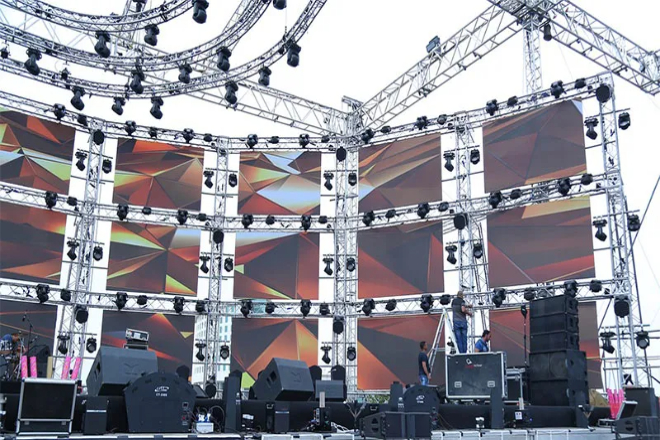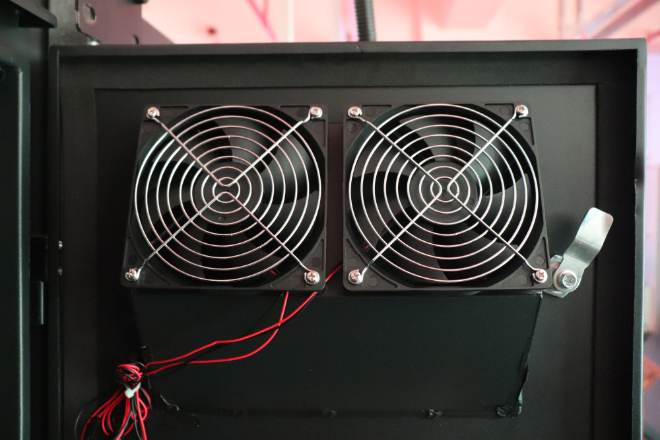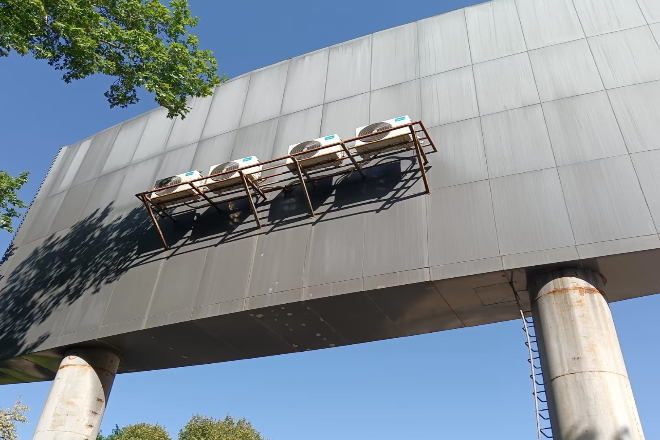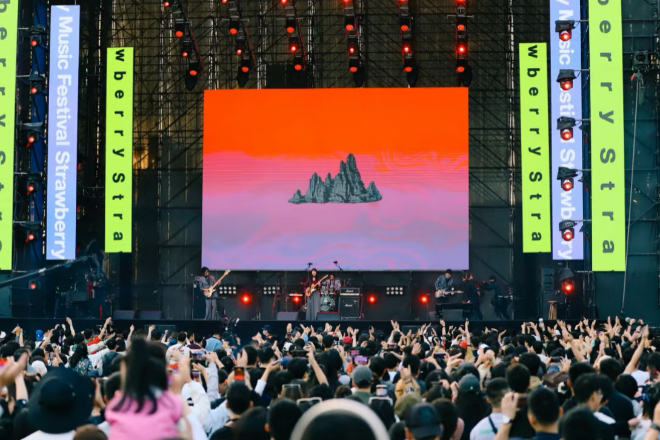Introduction
In large-scale summer events, Écrans d'affichage LED, as important visual display tools, often face severe challenges in high-temperature environments.
How can it ensure its stable operation in the hot summer and avoid failures caused by heat dissipation problems?
This is not only a technical problem, but also the key to the success of the event. So, how should the heat dissipation problem of LED display screens be dealt with?
Table des matières
1. Potential threats of a high-temperature environment to LED display screens

1). Performance degradation
High temperature has a great impact on the performance of LED display screens. First of all, poor chip heat dissipation is a big problem. The core of the LED display screen is the chip, which will generate heat when working.
If the ambient temperature is high and the heat dissipation system cannot keep up, the chip will overheat.
Once overheated, the movement of electrons in the chip slows down, the luminous efficiency decreases, and the brightness naturally becomes dim.
Secondly, high temperatures will also make the display effect worse. The luminous wavelength of the chip will drift as the temperature rises, and chips of different colours will be affected differently, which will lead to poor colour reproduction, colour cast and distortion.
Moreover, high temperature will make the driving circuit unstable, and signal transmission is prone to problems, such as flickering, tailing, and abnormal pixels, and the overall display effect will be very blurred.
2). Shortened lifespan
High temperatures will also shorten the lifespan of LED display screens. There are many electronic components in the display screen, such as capacitors, resistors, and driver chips.
Under high temperatures, the performance of these components will deteriorate. The electrolyte of the capacitor will evaporate faster, the capacity will decrease, and the circuit will be unstable.
The resistance value of the resistor will also change, and the current and voltage distribution will be uneven. These components age quickly, and the lifespan of the display screen will naturally be short.
In addition, the chip itself also has a temperature resistance limit.
When the ambient temperature is high, the crystal structure inside the chip will be destroyed, the defects will increase, and the luminous efficiency and lifespan will be affected.
Under long-term high temperatures, the chip light decay will accelerate, the brightness will drop rapidly, and the display screen will soon be scrapped.
3). Safety hazards
High temperatures will also bring safety hazards. First, the risk of a short circuit increases. High temperatures will make the insulating material age, become brittle, and even crack.
Once the insulating layer is broken, it is easy for conductors with different potentials to short-circuit.
When a short circuit occurs, the current will increase instantly, which may burn the circuit board and chip, or even cause more serious electrical failures.
Second, the risk of fire is also great. If the heat dissipation system is not good, the internal temperature of the display screen is too high, which may ignite the flammable materials such as plastic and rubber inside, causing a fire.
Moreover, the electric sparks generated by the short circuit may also ignite the surrounding things, and the fire will expand rapidly, with disastrous consequences.
2. Why is heat dissipation so important for LED displays in large-scale summer events

The weather is hot in summer, especially outdoors, and the temperature can easily exceed 35℃.
Under such high temperatures, the LED display screen is like working in a high-temperature environment, and the internal chips and other electronic components are easy to overheat.
If the heat dissipation is not good, the temperature of the display screen will rise rapidly, exceeding its normal operating temperature range, causing various problems.
When the LED display screen is running, especially when playing high-definition video or high-luminosité content, it consumes a lot of power and also generates a lot of heat.
For example, when a large LED display screen is fully lit, the internal temperature may be more than ten degrees or even dozens of degrees higher than the ambient temperature.
If this heat cannot be dissipated in time, it will continue to accumulate, causing the internal temperature of the display screen to be too high and affecting normal operation.
If the heat dissipation is not good, the performance of the LED display will be significantly reduced.
First, poor heat dissipation of the chip will lead to reduced luminous efficiency and dimming of brightness, affecting the viewing experience.
Second, high temperature will cause the luminous wavelength of the chip to drift, resulting in colour deviation, colour cast or colour distortion, and poor display effect.
In addition, high temperature will also make the driving circuit unstable, causing flickering, tailing, pixel abnormality, and other problems, as well as even causing the display to crash in severe cases.
If the heat dissipation is not good, the electronic components inside the display will age faster.
There are many electronic components inside the display, such as capacitors, resistors, and driver chips.
At high temperatures, the ageing speed of these components will accelerate.
For example, the electrolyte of the electrolytic capacitor will evaporate faster, and the resistance value of the resistor will change, which will affect the stability and service life of the display.
At the same time, the chip is more easily damaged at high temperatures, the light decay is accelerated, the brightness drops rapidly, and the service life of the display will be greatly shortened.
Poor heat dissipation will also bring serious safety hazards. High temperature can cause the insulating material to age, become brittle, or even crack, which can easily lead to short circuits.
When a short circuit occurs, the current will increase sharply, which may burn key components such as circuit boards and chips, or even cause more serious electrical failures.
In addition, if the heat dissipation system fails and the temperature inside the display is too high, it may ignite the internal flammable materials such as plastic and rubber, or even cause a fire, resulting in serious consequences.
In large-scale events, LED display screens are very important equipment for playing advertisements, program content or live broadcasts, etc.
If the display screen fails due to heat dissipation problems, it will not only affect the normal progress of the event, but also cause huge economic losses and reputation damage to the organiser.
For example, at a large des sports event or concert, the failure of the display screen may prevent the audience from watching the game or performance normally, causing dissatisfaction among the audience.
Therefore, heat dissipation measures are crucial for LED display screens.
In order to cope with the high temperatures in summer, the display screen is usually equipped with an efficient heat dissipation system, such as heat sinks, fans, thermal conductive materials, etc.
These heat dissipation measures can effectively reduce the temperature inside the display screen and ensure that it can work normally even in high-temperature environments.
For example, some outdoor LED screens will exhaust heat through fans, while some large indoor screens will use liquid cooling technology to further improve the heat dissipation efficiency.
In short, good heat dissipation measures are the key to ensuring the stable operation of LED screens in large-scale summer events.
3. What are the ways to dissipate heat for LED screens in large-scale summer events?
1). Natural cooling
Natural cooling is to dissipate heat through the vents on the display cabinet and the surrounding air flow.
Simply put, it is to let the cold air come in from the bottom or side of the cabinet, and the hot air runs out from the top or back.
This method relies entirely on natural air convection, does not require additional power equipment, is low-cost and environmentally friendly.
Just like you open the window to let the heat in the house dissipate, the heat in the display will also be taken away in this way.
This method is particularly suitable for those displays with low power and low heat generation, such as some small indoor displays.
This kind of LED display is usually used indoors, where the temperature is relatively stable, and natural cooling is sufficient.
However, if the ambient temperature itself is very high, it may require additional cooling.
For example, in a hot summer or if the LED display is installed in a poorly ventilated place, the effect of natural cooling is not so ideal.
It is like being in a hot and stuffy small room. Just opening the window may not blow away much heat.

2). Fan cooling
Fan cooling involves installing a fan inside or outside the LED display screen and using the fan to blow away the heat. The fan can actively promote air flow, which is much better than natural cooling.
Just like you use an electric fan to blow air on a hot day, the wind blown by the fan can quickly take away the heat.
The advantage of this method is that the cost is not high, and the appropriate fan can be selected according to the size and heat generation of the display screen.
For example, for some medium-power display screens, a small axial fan can be installed, and for high-power display screens, a higher-power centrifugal fan can be installed.
However, after the fan is used for a long time, dust will accumulate on it, and the dust will affect the fan speed and air circulation, thereby reducing the heat dissipation effect.
Therefore, it is important to clean the fan regularly. Otherwise, the fan will be like a blocked water pipe, the air volume will decrease, and the heat dissipation effect will also deteriorate.

3). Air conditioning cooling
For those large-area, high-power LED display screens, especially large outdoor screens, air conditioning cooling is very necessary.
The air conditioner has a strong cooling capacity and can quickly discharge the heat in the display screen through the circulation of refrigerant.
It is like you stay in an air-conditioned room in the hot summer, and the air conditioner can quickly take away the heat in the room and make you feel cool.
This method is particularly suitable for large outdoor displays because these displays usually work in high-temperature environments, and they are large in area and generate high heat.
When choosing an air conditioner, you should choose the appropriate power according to the area of the display screen and the installation environment.
Generally speaking, a 2-horsepower air conditioner is enough for a 20-square-meter outdoor display screen.
Although the cost of air conditioning heat dissipation is relatively high, it can ensure that the display screen can work normally in hot weather and will not have problems due to overheating.
It is like putting a “cooling vest” on the display screen, allowing it to work “calmly” in the hot summer.
4. Points à noter

1). The heat dissipation method should be selected according to the situation
1.1). Don’t choose the heat dissipation method blindly:
If it is a small screen, placed indoors, the power is not high, and natural heat dissipation is enough.
But if it is a large screen, especially the outdoor one, with high power and high heat, then you have to use a fan or air conditioner to dissipate heat.
For example, a 20 square meter outdoor large screen is reliable with a 2-horsepower air conditioner.
1.2). The installation environment is also critical:
If the display screen is placed outdoors, the temperature is high in the summer when it is directly exposed to the sun, so the heat dissipation method must be “upgraded”.
If the indoor ventilation is not good, you can’t just rely on natural heat dissipation. Otherwise, it will definitely not work.
2). Regular inspection and maintenance must not be forgotten
2.1). The fan must be cleaned regularly:
The fan will accumulate dust after being used for a long time, the air volume will become smaller, and the heat dissipation effect will also become worse.
Therefore, check the fan every once in a while (for example, once a month) to see if there is any dust accumulation, and clean it up in time if there is.
2.2). The air conditioner also needs regular maintenance:
If the air conditioner is used for heat dissipation, the air conditioner filter and refrigerant also need to be checked regularly.
A dirty filter will affect the cooling effect of the air conditioner, and insufficient refrigerant will also make the air conditioner “unable to do its job”.
Therefore, it is very important to clean the filter and check the refrigerant regularly.
2.3). Don’t block the vents:
For naturally cooling displays, the vents cannot be blocked. If the vents are blocked by dust or debris, air cannot enter or exit, and the cooling effect will be greatly reduced.
Therefore, check the vents regularly to ensure that they are unobstructed.
3). Pay attention to weather changes
3.1). Pay special attention to hot weather:
In summer, the weather is hot, especially for outdoor displays, and the temperature can easily soar.
If you encounter continuous high temperatures, even if the cooling system is sufficient, it may not be able to dissipate enough heat.
At this time, you may need to temporarily add some cooling measures, such as installing an additional fan or adjusting the brightness of the display (the higher the brightness, the greater the heat).
3.2). Pay attention to waterproofing on rainy days:
Although waterproofing and heat dissipation seem unrelated, if the display is flooded, it may cause a short circuit, which in turn affects the cooling system.
Therefore, on rainy days, make sure that the waterproofing measures of the display are in place to prevent rain from entering the interior of the display.
4). Backup cooling equipment is necessary
4.1). Prepare backup cooling equipment:
In large-scale events, once the display screen has a cooling problem, it may cause the event to be interrupted and cause great losses.
Therefore, it is best to prepare some backup cooling equipment, such as additional fans or small air conditioners, just in case.
If the main cooling system fails, you can switch to the backup equipment in time to ensure the normal operation of the display screen.
4.2). Test the cooling system in advance:
Before the event starts, the cooling system should be fully tested to ensure that it can work properly. When testing, it is best to simulate the actual usage scenario.
For example, let the display screen run at full luminosité for a period of time to see if the cooling system can effectively control the temperature.
5. Conclusion
By understanding the potential threat of high temperature environment to LED display screens, as well as the advantages and disadvantages of various heat dissipation methods.
We clearly realize that scientific and reasonable heat dissipation measures are the “key” to ensure the stable operation of LED display screens.
Whether it is natural cooling, fan cooling or air conditioning cooling, choosing the right cooling method and regular maintenance can make the display screen work “calmly” in a high-temperature environment and ensure the smooth progress of the event.
Enfin, si vous souhaitez en savoir plus sur les écrans d'affichage LED, veuillez nous contacter.
